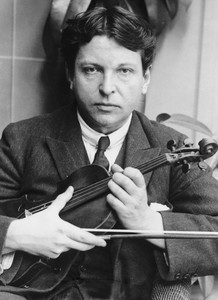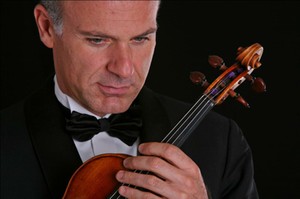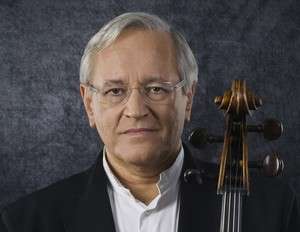
Cesar Franck |
Contents
César Franck
…There is no purer name than that of this great simple-hearted soul. Almost everyone who approached Frank experienced his irresistible charm… R. Rollan

Franck is an unusual figure in French musical art, an outstanding, peculiar personality. R. Rolland wrote about him on behalf of the hero of the novel Jean Christophe: “… this unearthly Frank, this saint from music managed to carry through a life full of hardships and despised labor, the unfading clarity of a patient soul, and hence that humble smile that overshadowed with light the good of his work.” K. Debussy, who did not escape the charm of Frank, recalled him: “This man, who was unhappy, unrecognized, had a childish soul so indestructibly kind that he could always contemplate the malevolence of people and the inconsistency of events without bitterness.” The testimonies of many prominent musicians about this man of rare spiritual generosity, amazing clarity and innocence, which did not at all speak of the cloudlessness of his life path, have been preserved.
Frank’s father belonged to an old family of Flemish court painters. Artistic family traditions allowed him to notice his son’s outstanding musical talent early, but the financier’s entrepreneurial spirit prevailed in his character, prompting him to exploit little Cesar’s pianistic talent for material gain. The thirteen-year-old pianist receives recognition in Paris – the capital of the musical world of those years, adorned with the stay of the world’s largest celebrities – F. Liszt, F. Chopin, V. Bellini, G. Donizetti, N. Paganini, F. Mendelssohn, J. Meyerbeer, G. Berlioz . Since 1835, Frank has been living in Paris and continuing his education at the conservatory. For Frank, composing is becoming increasingly important, which is why he breaks with his father. The milestone in the composer’s biography was the year 1848, which was important for the history of France – the rejection of concert activity for the sake of composing, his marriage to Felicite Demousso, the daughter of the actors of the French comedy theater. Interestingly, the last event coincides with the revolutionary events of February 22 – the wedding cortege is forced to climb over the barricades, in which the rebels helped them. Frank, who did not fully understand the events, considered himself a republican and responded to the revolution by composing a song and a choir.
The need to provide for his family forces the composer to constantly engage in private lessons (from an advertisement in the newspaper: “Mr. Cesar Franck … resumes private lessons …: piano, theoretical and practical harmony, counterpoint and fugue …”). He could not afford to give up this daily long hours of exhausting work until the end of his days and even received an injury from the push of an omnibus on the way to one of his students, which subsequently led him to death.
Late came to Frank recognition of his composer’s work – the main business of his life. He experienced his first success only at the age of 68, while his music earned world recognition only after the death of the creator.
However, any hardships of life did not shake the healthy fortitude, naive optimism, benevolence of the composer, which aroused the sympathy of his contemporaries and descendants. He found that going to class was good for his health and knew how to enjoy even a mediocre performance of his works, often taking the indifference of the public for a warm welcome. Apparently, this also affected the national identity of his Flemish temperament.
Responsible, precise, calmly stern, noble was Frank in his work. The composer’s lifestyle was selflessly monotonous – getting up at 4:30, 2 hours of work for himself, as he called the composition, at 7 in the morning he already went to lessons, returning home only for dinner, and if they didn’t come to him in that day, his students were in the class of organ and composition, he still had a couple of hours to finalize his works. Without exaggeration, this can be called a feat of selfless work not for the sake of money or success, but for the sake of loyalty to oneself, the cause of one’s life, one’s vocation, the highest skill.
Frank created 3 operas, 4 oratorios, 5 symphonic poems (including the Poem for Piano and Orchestra), often performed Symphonic Variations for Piano and Orchestra, a magnificent Symphony, chamber-instrumental works (in particular, those that found successors and imitators in France Quartet and Quintet), Sonata for Violin and Piano, beloved by performers and listeners, romances, piano works (large single-movement compositions – Prelude, chorale and fugue and Prelude, aria and finale deserve special recognition from the public), about 130 pieces for organ.
Frank’s music is always significant and noble, animated by a lofty idea, perfect in construction and at the same time full of sound charm, colorfulness and expressiveness, earthly beauty and sublime spirituality. Franck was one of the creators of French symphonic music, opening together with Saint-Saens an era of large-scale, serious and significant in thought symphonic and chamber works. In his Symphony, the combination of a romantically restless spirit with classical harmony and proportionality of form, organ density of sound creates a unique image of an original and original composition.
Frank’s sense of “material” was amazing. He mastered the craft in the highest sense of the word. Despite the work in fits and starts, there are no breaks and raggedness in his works, the musical thought flows continuously and naturally. He had a rare ability to continue composing from any place where he had to interrupt, he did not need to “enter” this process, apparently, he constantly carried his inspiration in himself. At the same time, he could work simultaneously on several works, and he never repeated twice the once found form, coming to a fundamentally new solution in each work.
Magnificent possession of the highest composing skill manifested itself in Frank’s organ improvisations, in this genre, almost forgotten since the time of the great J. S. Bach. Frank, a well-known organist, was invited to the solemn ceremonies of the opening of new organs, such an honor was awarded only to the largest organists. Until the end of his days, at least two or three times a week, Frank played in the church of St. Clotilde, striking with his art not only the parishioners. Contemporaries recall: “… he came to kindle the flame of his brilliant improvisations, often more valuable than many carefully processed samples, we … forgot about everything in the world, contemplating an intensely attentive profile and especially a powerful forehead, around which, as it were, inspired melodies and exquisite harmonies reflected by the pilasters of the cathedral: filling it, they were then lost above in its vaults. Liszt heard Frank’s improvisations. A student of Frank W. d’Andy writes: “Leszt left the church … sincerely excited and delighted, uttering the name of J. S. Bach, a comparison with which arose in his mind by itself … “These poems are destined for a place next to the masterpieces of Sebastian Bach!” he exclaimed.
The influence of organ sound on the style of the composer’s piano and orchestral works is great. So, one of his most popular works – Prelude, Chorale and Fugue for Piano – is inspired by organ sounds and genres – an excited toccata prelude covering the entire range, a calm gait of a chorale with a feeling of a continuously drawn-out organ sound, a large-scale fugue with Bach’s intonations of a sigh-complaint, and the pathos of the music itself, the breadth and loftiness of the theme, as it were, brought into the piano art the speech of a devout preacher, convincing mankind of the loftiness, mournful sacrifice and ethical value of his destiny.
True love for music and for his students permeated Frank’s teaching career at the Paris Conservatoire, where his organ class became the center of the study of composition. The search for new harmonic colors and forms, interest in modern music, amazing knowledge of a huge number of works by various composers attracted young musicians to Frank. Among his students were such interesting composers as E. Chausson or V. d’Andy, who opened the Schola cantorum in memory of the teacher, designed to develop the traditions of the great master.
The composer’s posthumous recognition was universal. One of his perspicacious contemporaries wrote: “Mr. Cesar Franck … will be considered in the XNUMXth century one of the greatest musicians of the XNUMXth.” Frank’s works adorned the repertoire of such major performers as M. Long, A. Cortot, R. Casadesus. E. Ysaye performed Franck’s Violin Sonata in the workshop of the sculptor O. Rodin, his face at the time of the performance of this amazing work was especially inspired, and the famous Belgian sculptor C. Meunier took advantage of this when creating a portrait of the famous violinist. The traditions of the composer’s musical thinking were refracted in the work of A. Honegger, partially reflected in the works of Russian composers N. Medtner and G. Catoire. Frank’s inspirational and strict music convinces of the value of the composer’s ethical ideals, which allowed him to become an example of high service to art, selfless devotion to his work and human duty.
V. Bazarnova
“… There is no name cleaner than the name of this great simple-hearted soul,” Romain Rolland wrote about Frank, “the soul of immaculate and radiant beauty.” A serious and deep musician, Frank did not achieve fame, he led a simple and secluded life. Nevertheless, modern musicians of different creative trends and artistic tastes treated him with great respect and reverence. And if Taneyev was called “the musical conscience of Moscow” in the heyday of his activity, then Frank with no less reason can be called the “musical conscience of Paris” of the 70s and 80s. However, this was preceded by many years of almost complete obscurity.
Cesar Franck (Belgian by nationality) was born in Liege on December 10, 1822. Having received his initial musical education in his native city, he graduated from the Paris Conservatoire in 1840. Returning then for two years to Belgium, he spent the rest of his life from 1843 working as an organist in Parisian churches. Being an unsurpassed improviser, he, like Bruckner, did not give concerts outside the church. In 1872, Frank received an organ class at the conservatory, which he led until the end of his days. He was not entrusted with the class of composition theory, nevertheless, his classes, which went far beyond the scope of organ performance, were attended by many even famous composers, including Bizet in his mature period of creativity. Frank took an active part in the organization of the National Society. During these years, his works begin to be performed; yet their success at first was not great. Frank’s music only received full recognition after his death – he died on November 8, 1890.
Frank’s work is deeply original. He is alien to the light, brilliance, liveliness of Bizet’s music, which are usually perceived as typical manifestations of the French spirit. But along with the rationalism of Diderot and Voltaire, the refined style of Stendhal and Mérimée, French literature also knows the language of Balzac overloaded with metaphors and complex verbosity, a penchant for Hugo’s hyperbole. It was this other side of the French spirit, enriched by the Flemish (Belgian) influence, that Frank vividly embodied.
His music is imbued with sublime mood, pathos, romantically unstable states.
Enthusiastic, ecstatic impulses are opposed by feelings of detachment, introspective analysis. Active, strong-willed melodies (often with a dotted rhythm) are replaced by plaintive, as if begging themes-calls. There are also simple, folk or choral melodies, but usually they are “enveloped” with a thick, viscous, chromatic harmony, with frequently used seventh and nonchords. The development of contrasting images is free and unconstrained, replete with oratorically intense recitatives. All this, like in Bruckner, resembles the manner of organ improvisation.
If, however, one tries to establish the musical and stylistic origins of Frank’s music, then first of all it will be necessary to name Beethoven with his last sonatas and quartets; at the beginning of his creative biography, Schubert and Weber were also close to Frank; later he experienced the influence of Liszt, partly Wagner – mainly in the warehouse of thematic, in searches in the field of harmony, texture; he was also influenced by the violent romanticism of Berlioz with the contrast characteristic of his music.
Finally, there is something in common that makes him related to Brahms. Like the latter, Frank tried to combine the achievements of romanticism with classicism, closely studied the heritage of early music, in particular, he paid much attention to the art of polyphony, variation, and the artistic possibilities of sonata form. And in his work, he, like Brahms, pursued highly ethical goals, bringing to the fore the theme of the moral improvement of man. “The essence of a musical work is in its idea,” Frank said, “it is the soul of music, and the form is only the corporeal shell of the soul.” Frank, however, differs significantly from Brahms.
For many decades, Frank, both practically, by the nature of his activity, and by conviction, was associated with the Catholic Church. This could not but affect his work. As a humanist artist, he broke out of the shadows of this reactionary influence and created works that were far from the ideology of Catholicism, exciting the truth of life, marked by remarkable skill; but still the composer’s views fettered his creative powers and sometimes directed him along the wrong path. Therefore, not all of his legacy is of interest to us.
* * *
Frank’s creative influence on the development of French music in the late XNUMXth and early XNUMXth centuries is enormous. Among the students close to him we meet the names of such major composers as Vincent d’Andy, Henri Duparc, Ernest Chausson.
But Frank’s sphere of influence was not limited to the circle of his students. He revived symphonic and chamber music to a new life, aroused interest in the oratorio, and gave it not a picturesque and pictorial interpretation, as was the case with Berlioz, but a lyrical and dramatic one. (Among all his oratorios, the largest and most significant work is The Beatitudes, in eight parts with a prologue, on the gospel text of the so-called Sermon on the Mount. The score of this work contains pages of excited, extremely sincere music (see, for example, the fourth part In the 80s, Frank tried his hand, though unsuccessfully, in the operatic genre (the Scandinavian legend Gulda, with dramatic ballet scenes, and the unfinished opera Gisela), He also has cult compositions, songs, romances, etc.) Finally, Frank greatly expanded the possibilities of musical expressive means, especially in the field of harmony and polyphony, the development of which French composers, his predecessors, sometimes paid insufficient attention to. But most importantly, with his music, Frank asserted the inviolable moral principles of a humanist artist who confidently defended high creative ideals.
M. Druskin
Compositions:
Dates of composition are given in parentheses.
Organ works (about 130 in total) 6 pieces for large organ: Fantasy, Grand Symphony, Prelude, Fugue and Variations, Pastoral, Prayer, Finale (1860-1862) Collection “44 small pieces” for organ or harmonium (1863, published posthumously) 3 Pieces for Organ: Fantasy, Cantabile, Heroic Piece (1878) Collection “Organist”: 59 pieces for harmonium (1889-1890) 3 chorales for large organ (1890)
Piano works Eclogue (1842) First Ballad (1844) Prelude, Chorale and Fugue (1884) Prelude, aria and finale (1886-1887)
There is, in addition, a number of small piano pieces (partially 4-hand), which mainly belong to the early period of creativity (written in the 1840s).
Chamber instrumental works 4 piano trios (1841-1842) Piano quintet in f minor (1878-1879) Violin Sonata A-dur (1886) String Quartet in D-dur (1889)
Symphonic and vocal-symphonic works “Ruth”, biblical eclogue for soloists, choir and orchestra (1843-1846) “Atonement”, a symphony poem for soprano, choir and orchestra (1871-1872, 2nd edition – 1874) “Aeolis”, symphonic poem, after a poem by Lecomte de Lisle (1876) The Beatitudes, oratorio for soloists, choir and orchestra (1869-1879) “Rebekah”, biblical scene for soloists, choir and orchestra, based on the poem by P. Collen (1881) “The Damned Hunter”, symphonic poem, based on the poem by G. Burger (1882) “Jinns”, symphonic poem for piano and orchestra, after the poem by V. Hugo (1884) “Symphonic Variations” for piano and orchestra (1885) “Psyche”, symphonic poem for orchestra and choir (1887-1888) Symphony in d-moll (1886-1888)
Opera Farmhand, libretto by Royer and Vaez (1851-1852, unpublished) Gould, libretto by Grandmougin (1882-1885) Gisela, libretto by Thierry (1888-1890, unfinished)
In addition, there are many spiritual compositions for various compositions, as well as romances and songs (among them: “Angel and Child”, “Wedding of Roses”, “Broken Vase”, “Evening Ringing”, “First Smile of May”).





